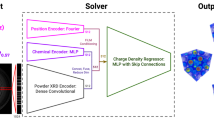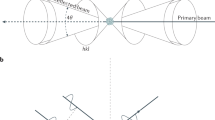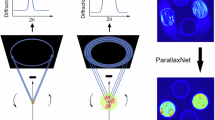Abstract
IN the modern techniques of high-resolution neutron and X-ray powder diffraction, an impressive amount of structural information may be obtained, allowing the refinement, using the Rietveld technique1, of structures containing more than 100 positional parameters. Despite these technical advances and the renewed popularity of the technique, powder diffraction suffers from the inevitable loss of information imposed by the collapse of three dimensions of diffraction data onto the one dimension of a powder pattern. This can seriously frustrate the determination of unknown crystal structures. As a consequence of accidental or exact reflection overlap, only relatively few reflections may have uniquely determined intensities. (For example, the cubic reflections 550, 710 and 543 exactly overlap.) Here I present a maximum-entropy algorithm (previously discussed theoretically2) that evaluates, from first principles, the intensities of overlapping reflections in powder diffraction profiles. Indeed, a full three-dimensional reconstruction of the image may be retrieved when only ∼20% of the reflections are uniquely determined. This precludes systems where the Patter-son group is not the holosymmetric group (for example, the 4/m symmetry where hkl and khl reflections are overlapping but not equivalent.) Nevertheless, for most crystal structures with unit cell volumes of less than 1,000 Å3, this method should be useful.
This is a preview of subscription content, access via your institution
Access options
Subscribe to this journal
Receive 51 print issues and online access
$199.00 per year
only $3.90 per issue
Buy this article
- Purchase on SpringerLink
- Instant access to full article PDF
Prices may be subject to local taxes which are calculated during checkout
Similar content being viewed by others
References
Rietveld, H. M. J. appl. Crystallogr. 2, 65–71 (1969).
David, W. I. F. J. appl. Crystallogr. 20, 316–319 (1987).
Gull, S. F. & Daniell, G. J. Nature 272, 686–690 (1978).
Livesey, A. K. & Skilling, J. Acta Crystallogr. A41, 113–122 (1985).
Bricogne, G. Acta Crystallogr. A40, 410–445 (1984).
Hull, S. & Mayers, J. User Guide for the Polaris Powder Diffractometer at ISIS, Rep. RAL-89-118 (Rutherford Appleton Laboratory, Chilton, 1989).
Pawley, G. S. J. appl. Crystallogr. 14, 347–361 (1981).
Egert, E. Acta Crystallogr. A39, 936–940 (1983).
Woolfson, M. M. Acta Crystallogr. A43, 593–612 (1987).
Ladd, M. F. C. & Palmer, R. A. (eds) Theory and Practice of Direct Methods in Crystallography (Plenum, London, 1980).
Rossmann, M. G., Arnold, E. & Vriend, G. Acta Crystallogr. A42, 325–334 (1986).
Karle, J. Acta Crystallogr. A45, 765–781 (1989).
Author information
Authors and Affiliations
Rights and permissions
About this article
Cite this article
David, W. Extending the power of powder diffraction for structure determination. Nature 346, 731–734 (1990). https://doi.org/10.1038/346731a0
Received:
Accepted:
Issue date:
DOI: https://doi.org/10.1038/346731a0
This article is cited by
-
Ab initio structure determination via powder X-ray diffraction
Journal of Chemical Sciences (2001)
-
Determination of complex structures by combined neutron and synchrotron X-ray powder diffraction
Nature (1992)



